Enabling Space-Aware Service Discovery Model in Home Networks through a Compatible Extension to mDNS/DNS-SD
Abstract
:1. Introduction
2. Related Works
3. Spatial Abstractions
3.1. Ambient
3.2. Spatial Expressions and Spatial Matching Semantic
4. Design
4.1. mDNS/DNS-SD Message Structure
- <Instance>._<Sub Type>._sub._<Service Type>._<Transportation Layer>.<Domain>,
- binaryLight1._binarylight._sub._http._tcp.local,
4.2. Formal Expressions for Specifying mDNS/DNS-SD Behaviors
4.3. Efficient Space-Aware Service Discovery Model with mDNS/DNS-SD
5. Evaluation
5.1. Implementation
5.2. Experiments
5.3. Discussions
5.3.1. Complex Spatial Query
5.3.2. Matching Efficiency of Spatial Expressions
5.3.3. System Initialization
5.3.4. Location Update and Dissemination
5.3.5. Working with LLNs
5.3.6. Interoperability
6. Conclusions
Author Contributions
Funding
Data Availability Statement
Conflicts of Interest
Abbreviations
| AST | Ambient structure tree |
| GPIO | General purpose input/output |
| LAN | Local area network |
| LLN | Low-power and lossy network |
| mDNS/DNS-SD | Multicast domain name system/DNS-based service discovery |
| QoS | Quality of service |
| RR | Resource record |
| SE | Spatial expression |
| SQE | Spatial query expression |
| SRE | Spatial response expression |
| WoT | Web of things |
References
- Villaverde, B.C.; de Paz Alberola, R.; Jara, A.J.; Fedor, S.; Das, S.K.; Pesch, D. Service Discovery Protocols for Constrained Machine-to-Machine Communications. IEEE Commun. Surv. Tutor. 2014, 16, 41–60. [Google Scholar] [CrossRef]
- Cheshire, S.; Krochmal, M. Multicast DNS; Technical Report, RFC 6762; Apple Inc.: Cupertino, CA, USA, 2013. [Google Scholar]
- Cheshire, S.; Krochmal, M. DNS-Based Service Discovery; Technical Report, RFC 6763; Apple Inc.: Cupertino, CA, USA, 2013. [Google Scholar]
- Cimmino, A.; McCool, M.; Tavakolizadeh, F.; Toumura, K. Web of Things (WoT) Discovery; Technical Report, W3C Working Draft; W3C: Cambridge, MA, USA, 2022. [Google Scholar]
- Baldauf, M.; Dustdar, S.; Rosenberg, F. A survey on context-aware systems. Int. J. Ad Hoc Ubiquitous Comput. 2007, 2, 263–277. [Google Scholar] [CrossRef]
- Stolikj, M.; Cuijpers, P.J.; Lukkien, J.J.; Buchina, N. Context based service discovery in unmanaged networks using mDNS/DNS-SD. In Proceedings of the 2016 IEEE International Conference on Consumer Electronics (ICCE), Las Vegas, Nevada, USA, 7–11 January 2016; pp. 163–165. [Google Scholar]
- Siljanovski, A.; Sehgal, A.; Schonwalder, J. Service discovery in resource constrained networks using multicast DNS. In Proceedings of the Networks and Communications (EuCNC), 2014 European Conference on IEEE, Bologna, Italy, 23–26 June 2014; pp. 1–5. [Google Scholar]
- Yan, Z.; Li, H.; Zeadally, S.; Zeng, Y.; Geng, G. Is DNS ready for ubiquitous internet of things? IEEE Access 2019, 7, 28835–28846. [Google Scholar] [CrossRef]
- Mahmoud, A.; Mahyoub, M.; Sheltami, T.; Abu-Amara, M. Traffic-aware auto-configuration protocol for service oriented low-power and lossy networks in IoT. Wirel. Netw. 2019, 25, 4231–4246. [Google Scholar] [CrossRef]
- Lee, K.; Kim, S.; Jeong, J.P.; Lee, S.; Kim, H.; Park, J.S. A framework for DNS naming services for Internet-of-Things devices. Future Gener. Comput. Syst. 2019, 92, 617–627. [Google Scholar] [CrossRef]
- Chiu, Y.H.; Liao, C.F.; Chen, K. Transparent web of things discovery in constrained networks based on mDNS/DNS-SD. In Proceedings of the 2021 International Conference on Platform Technology and Service (PlatCon), Jeju, Republic of Korea, 23–25 August 2021; pp. 1–6. [Google Scholar]
- Chiu, Y.H.; Liao, C.F. WeBLE: A BLE-based system compliant with WoT architecture. In Proceedings of the 2022 27th Asia Pacific Conference on Communications (APCC), Jeju, Republic of Korea, 19–21 October 2022; pp. 453–454. [Google Scholar]
- Stolikj, M.; Lukkien, J.J.; Cuijpers, P.J.; Buchina, N. Nomadic service discovery in smart cities. In Smart Cities and Homes; Elsevier: Amsterdam, The Netherlands, 2016; pp. 59–90. [Google Scholar]
- Cinque, M.; Della Corte, R.; Iorio, R.; Pecchia, A. An Exploratory Study on Zeroconf Monitoring of Microservices Systems. In Proceedings of the 2018 14th European Dependable Computing Conference (EDCC), Iași, Romania, 10–14 September 2018; pp. 112–115. [Google Scholar]
- Zorgati, H.; Djemaa, R.B.; Amor, I.A.B. Service discovery techniques in internet of things: A survey. In Proceedings of the 2019 IEEE International Conference on Systems, Man and Cybernetics (SMC), Bari, Italy, 6–9 October 2019; pp. 1720–1725. [Google Scholar]
- Natarajan, B.; Obaidat, M.S.; Sadoun, B.; Manoharan, R.; Ramachandran, S.; Velusamy, N. New clustering-based semantic service selection and user preferential model. IEEE Syst. J. 2020, 15, 4980–4988. [Google Scholar] [CrossRef]
- Hafsi, A.; Gamha, Y.; Njima, C.B.; Romdhane, L.B. A SOAF model extension for incorporating user feedback and preference to improve social service discovery. In Proceedings of the 2021 IEEE International Conference on Services Computing (SCC), Virtual Conference, 5–11 September 2021; pp. 376–381. [Google Scholar]
- Kunhoth, J.; Karkar, A.; Al-Maadeed, S.; Al-Ali, A. Indoor positioning and wayfinding systems: A survey. Hum.-Centric Comput. Inf. Sci. 2020, 10, 1–41. [Google Scholar] [CrossRef]
- Jain, P.; Khanwalkar, S.S.; Malhotra, R.; Dheenrajappa, A.; Gupta, G.; Kobsa, A. uBeacon: Configuration based Beacon tracking. In Proceedings of the 2016 IEEE International Conference on Pervasive Computing and Communication Workshops (PerCom Workshops), Sydney, NSW, Australia, 14–18 March 2016; pp. 1–4. [Google Scholar]
- Cardelli, L.; Gordon, A.D. Mobile ambients. In Proceedings of the International Conference on Foundations of Software Science and Computation Structure, Lisbon, Portugal, 28 March–4 April 1998; Springer: Berlin/Heidelberg, Germany, 1998; pp. 140–155. [Google Scholar]
- Kato, T.; Hirashima, Y. The Synchronized Ambient Calculus; Social Science Research Network: Amsterdam, The Netherlands, 2022. [Google Scholar]
- Glushkova, T.; Stoyanov, S.; Rusev, K.; Krasteva, I.; Moraliyska, N. ambient-oriented CCA Modeling in Agriculture. In Proceedings of the 2021 International Conference Automatics and Informatics (ICAI), Arequipa, Peru, 30 September–2 October 2021; pp. 310–313. [Google Scholar]
- Liao, C.F.; Fu, H.Y. Spatial-aware service management in a pervasive environment. Serv. Oriented Comput. Appl. 2018, 12, 95–110. [Google Scholar] [CrossRef]
- Mockapetris, P.V. Rfc1035: Domain Names-Implementation and Specification. 1987. Available online: https://www.rfc-editor.org/info/rfc1035 (accessed on 11 September 2023).
- Jara, A.J.; Martinez-Julia, P.; Skarmeta, A. Light-weight multicast DNS and DNS-SD (lmDNS-SD): IPv6-based resource and service discovery for the web of things. In Proceedings of the 2012 Sixth International Conference on Innovative Mobile and Internet Services in Ubiquitous Computing, Palermo, Italy, 4–6 July 2012; pp. 731–738. [Google Scholar]
- Mahyoub, M.; Mahmoud, A.; Sheltami, T. An optimized discovery mechanism for smart objects in IoT. In Proceedings of the 2017 8th IEEE Annual Information Technology, Electronics and Mobile Communication Conference (IEMCON), Vancouver, BC, Canada, 3–5 October 2017; pp. 649–655. [Google Scholar]
- Christian, P. Models at REST or modelling RESTful interfaces for the Internet of Things. In Proceedings of the 2015 IEEE 2nd World Forum on internet of things (WF-IoT), Milan, Italy, 14–16 December 2015; pp. 251–255. [Google Scholar]
- Liao, C.F.; Chen, P.Y. ROSA: Resource-Oriented Service Management Schemes for web of things in a smart home. Sensors 2017, 17, 2159. [Google Scholar] [CrossRef] [PubMed]
- Raggett, D. The web of things: Challenges and opportunities. Computer 2015, 48, 26–32. [Google Scholar] [CrossRef]
- Benedikt, M.; Koch, C. XPath leashed. ACM Comput. Surv. (CSUR) 2009, 41, 1–54. [Google Scholar] [CrossRef]
- Adams, J.T. An introduction to IEEE STD 802.15.4. In Proceedings of the 2006 IEEE Aerospace Conference, Big Sky, MT, USA, 4–11 March 2006; p. 8. [Google Scholar]
- Lian, W.; Rescorla, E.; Shacham, H.; Savage, S. Measuring the Practical Impact of DNSSEC Deployment. In Proceedings of the 22nd USENIX Security Symposium (USENIX Security 13), Washington, DC, USA, 14–16 August 2013; pp. 573–588. [Google Scholar]
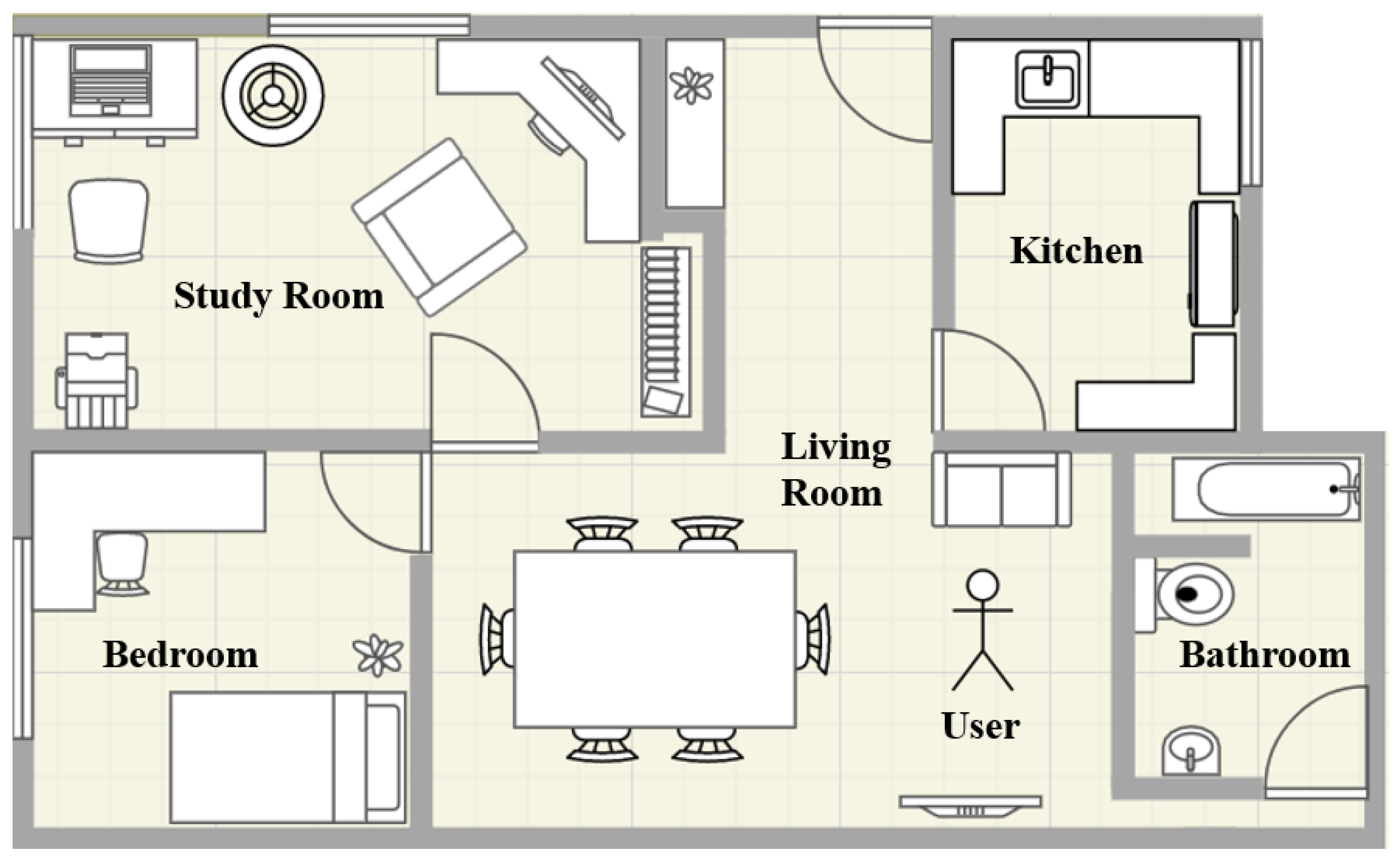
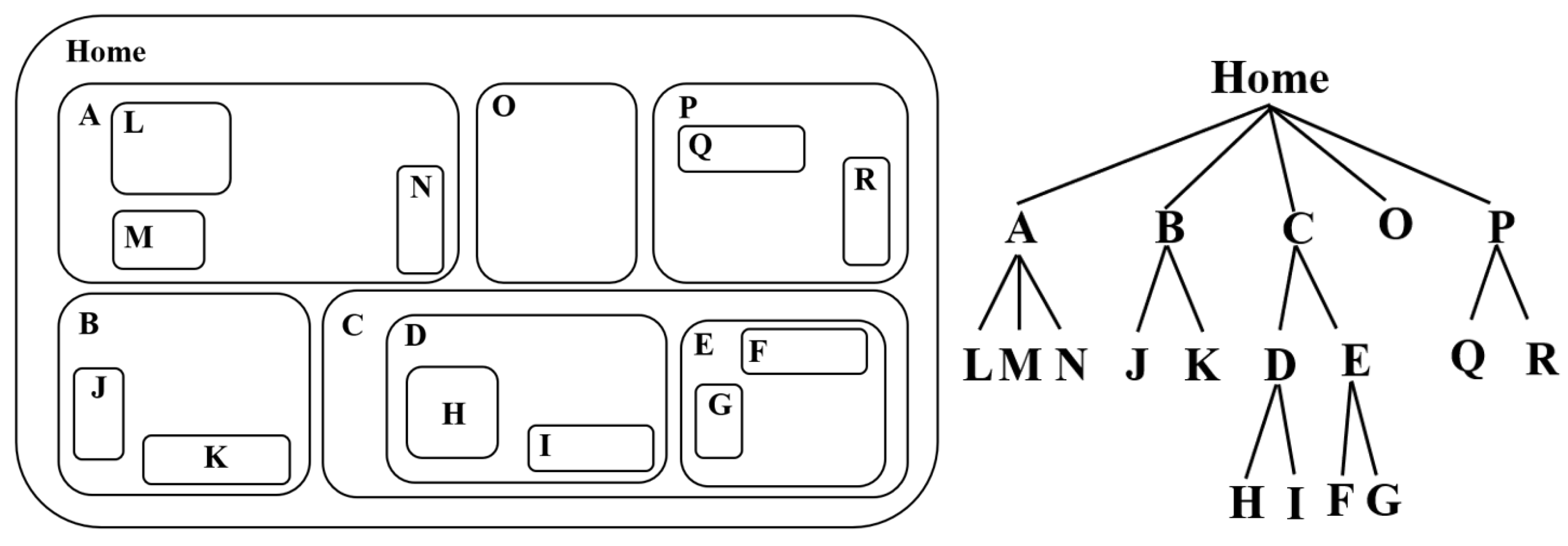
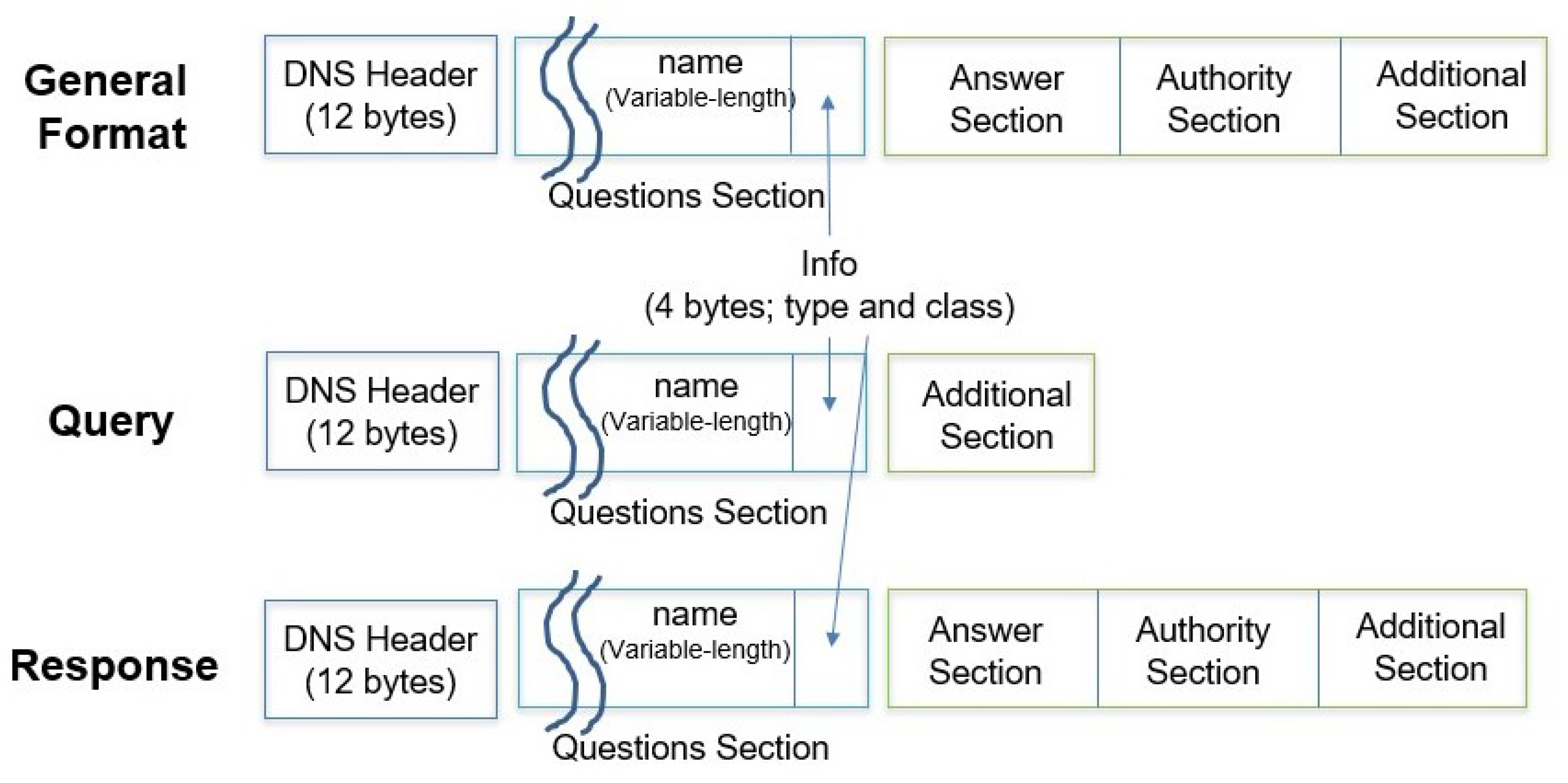
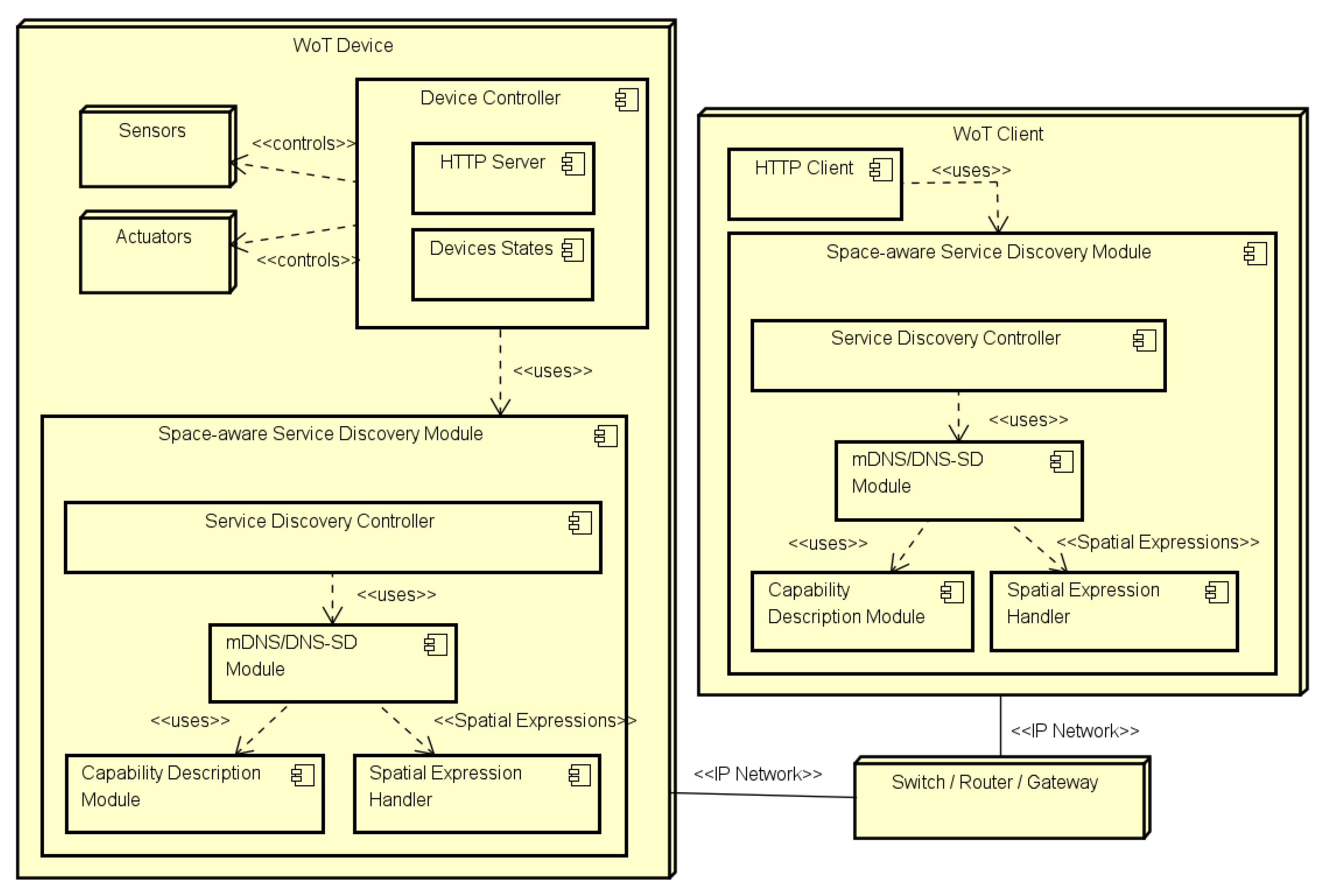

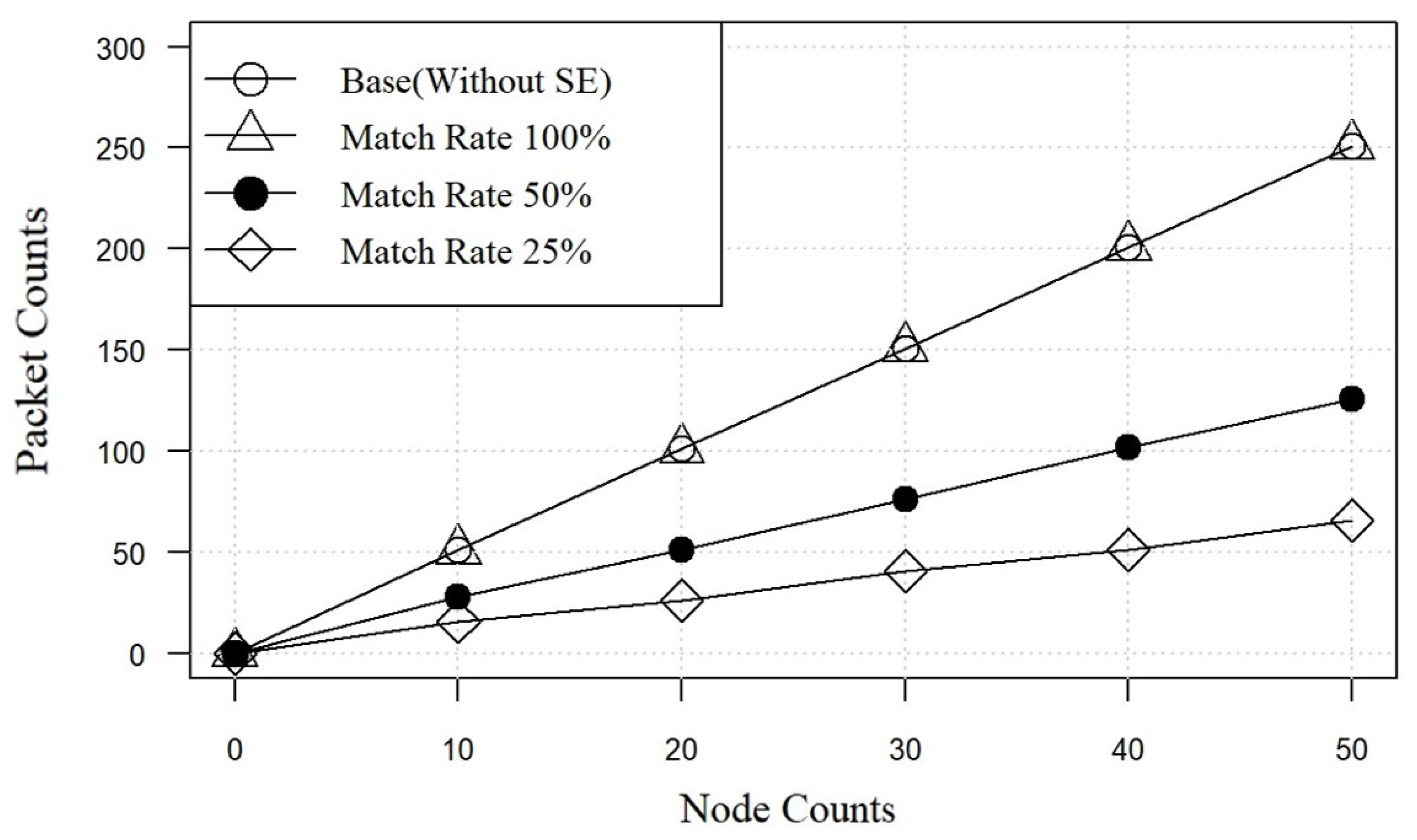


Disclaimer/Publisher’s Note: The statements, opinions and data contained in all publications are solely those of the individual author(s) and contributor(s) and not of MDPI and/or the editor(s). MDPI and/or the editor(s) disclaim responsibility for any injury to people or property resulting from any ideas, methods, instructions or products referred to in the content. |
© 2023 by the authors. Licensee MDPI, Basel, Switzerland. This article is an open access article distributed under the terms and conditions of the Creative Commons Attribution (CC BY) license (https://creativecommons.org/licenses/by/4.0/).
Share and Cite
Liao, C.-F.; Weng, Y.-J. Enabling Space-Aware Service Discovery Model in Home Networks through a Compatible Extension to mDNS/DNS-SD. Electronics 2023, 12, 3885. https://doi.org/10.3390/electronics12183885
Liao C-F, Weng Y-J. Enabling Space-Aware Service Discovery Model in Home Networks through a Compatible Extension to mDNS/DNS-SD. Electronics. 2023; 12(18):3885. https://doi.org/10.3390/electronics12183885
Chicago/Turabian StyleLiao, Chun-Feng, and Yu-Jou Weng. 2023. "Enabling Space-Aware Service Discovery Model in Home Networks through a Compatible Extension to mDNS/DNS-SD" Electronics 12, no. 18: 3885. https://doi.org/10.3390/electronics12183885
APA StyleLiao, C.-F., & Weng, Y.-J. (2023). Enabling Space-Aware Service Discovery Model in Home Networks through a Compatible Extension to mDNS/DNS-SD. Electronics, 12(18), 3885. https://doi.org/10.3390/electronics12183885






